BSBPMG508A Project: Risk Management Plan for Blue Mountains TAFE
VerifiedAdded on 2023/04/06
|23
|5280
|136
Project
AI Summary
This assignment requires the creation of a Risk Management Plan for a construction project at the WSI Blue Mountains TAFE. The student is tasked with developing a plan that complies with relevant industry and Australian standards, specifically AS/NZS ISO 31000:2009. The project involves a new facility for Beauty Therapy and Complimentary Health classrooms. The assignment necessitates the use of a provided template and the inclusion of a Risk Register. The plan should detail the processes for identifying, analyzing, evaluating, and treating risks, as well as outlining mitigation strategies, review processes, and responsibilities. The document should include an executive summary, introduction, risk assessment, mitigation, monitoring, and roles and responsibilities sections, and a risk register as an appendix. The student is expected to consider various risk categories such as contractual, technical, logistical, construction, and financial risks, relevant to a small to medium-sized construction company.
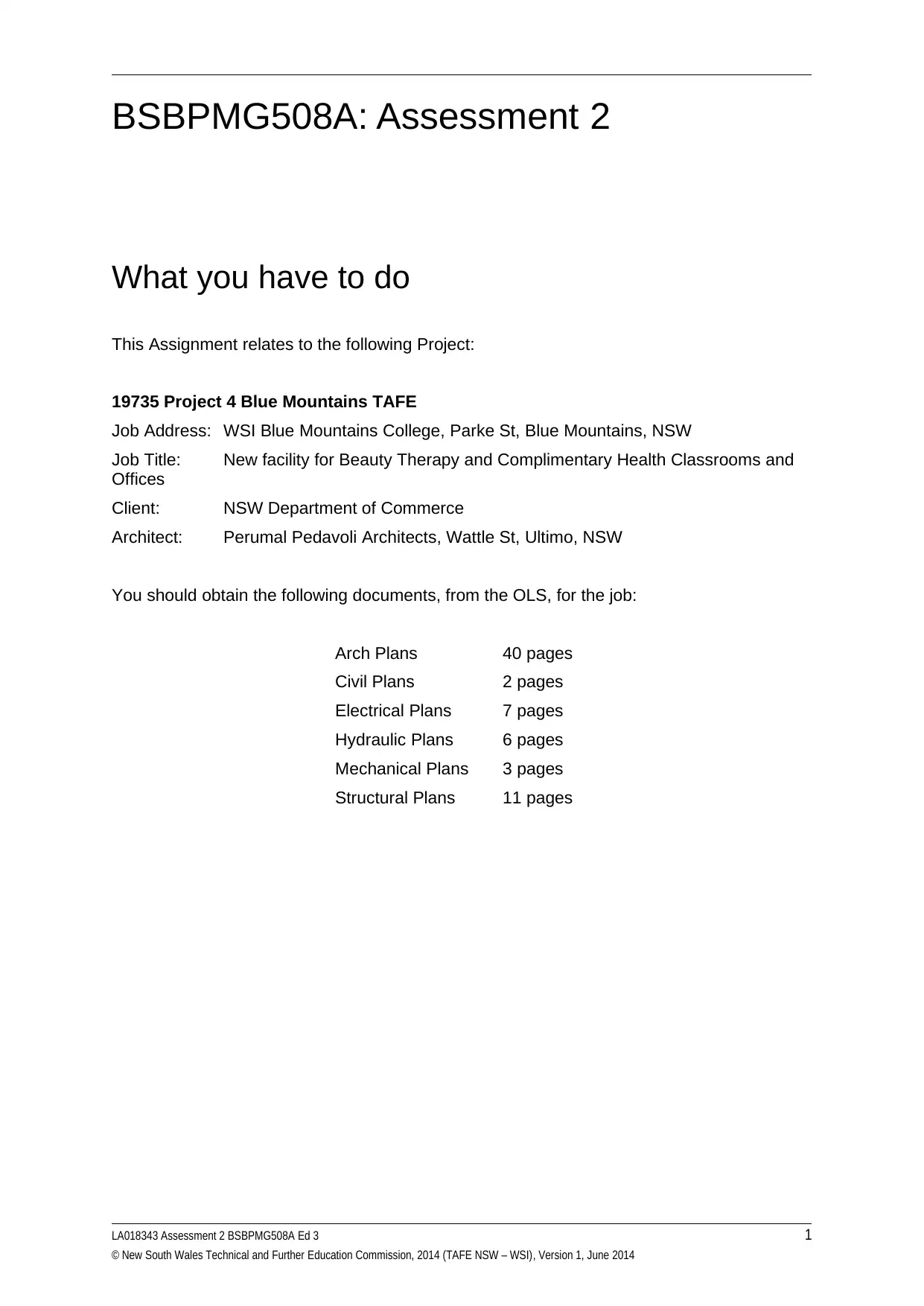
BSBPMG508A: Assessment 2
What you have to do
This Assignment relates to the following Project:
19735 Project 4 Blue Mountains TAFE
Job Address: WSI Blue Mountains College, Parke St, Blue Mountains, NSW
Job Title: New facility for Beauty Therapy and Complimentary Health Classrooms and
Offices
Client: NSW Department of Commerce
Architect: Perumal Pedavoli Architects, Wattle St, Ultimo, NSW
You should obtain the following documents, from the OLS, for the job:
Arch Plans 40 pages
Civil Plans 2 pages
Electrical Plans 7 pages
Hydraulic Plans 6 pages
Mechanical Plans 3 pages
Structural Plans 11 pages
LA018343 Assessment 2 BSBPMG508A Ed 3 1
© New South Wales Technical and Further Education Commission, 2014 (TAFE NSW – WSI), Version 1, June 2014
What you have to do
This Assignment relates to the following Project:
19735 Project 4 Blue Mountains TAFE
Job Address: WSI Blue Mountains College, Parke St, Blue Mountains, NSW
Job Title: New facility for Beauty Therapy and Complimentary Health Classrooms and
Offices
Client: NSW Department of Commerce
Architect: Perumal Pedavoli Architects, Wattle St, Ultimo, NSW
You should obtain the following documents, from the OLS, for the job:
Arch Plans 40 pages
Civil Plans 2 pages
Electrical Plans 7 pages
Hydraulic Plans 6 pages
Mechanical Plans 3 pages
Structural Plans 11 pages
LA018343 Assessment 2 BSBPMG508A Ed 3 1
© New South Wales Technical and Further Education Commission, 2014 (TAFE NSW – WSI), Version 1, June 2014
Paraphrase This Document
Need a fresh take? Get an instant paraphrase of this document with our AI Paraphraser
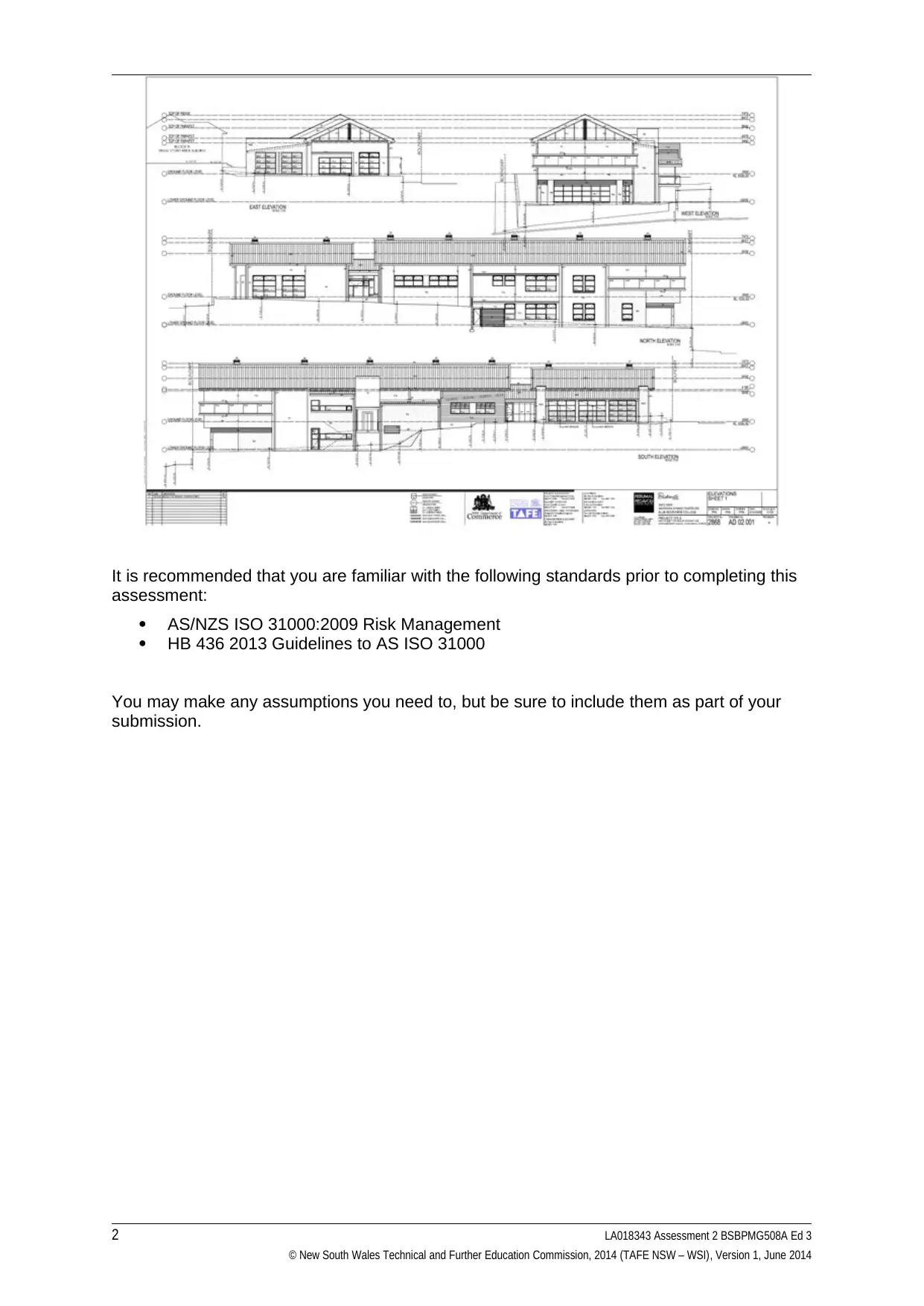
It is recommended that you are familiar with the following standards prior to completing this
assessment:
AS/NZS ISO 31000:2009 Risk Management
HB 436 2013 Guidelines to AS ISO 31000
You may make any assumptions you need to, but be sure to include them as part of your
submission.
2 LA018343 Assessment 2 BSBPMG508A Ed 3
© New South Wales Technical and Further Education Commission, 2014 (TAFE NSW – WSI), Version 1, June 2014
assessment:
AS/NZS ISO 31000:2009 Risk Management
HB 436 2013 Guidelines to AS ISO 31000
You may make any assumptions you need to, but be sure to include them as part of your
submission.
2 LA018343 Assessment 2 BSBPMG508A Ed 3
© New South Wales Technical and Further Education Commission, 2014 (TAFE NSW – WSI), Version 1, June 2014
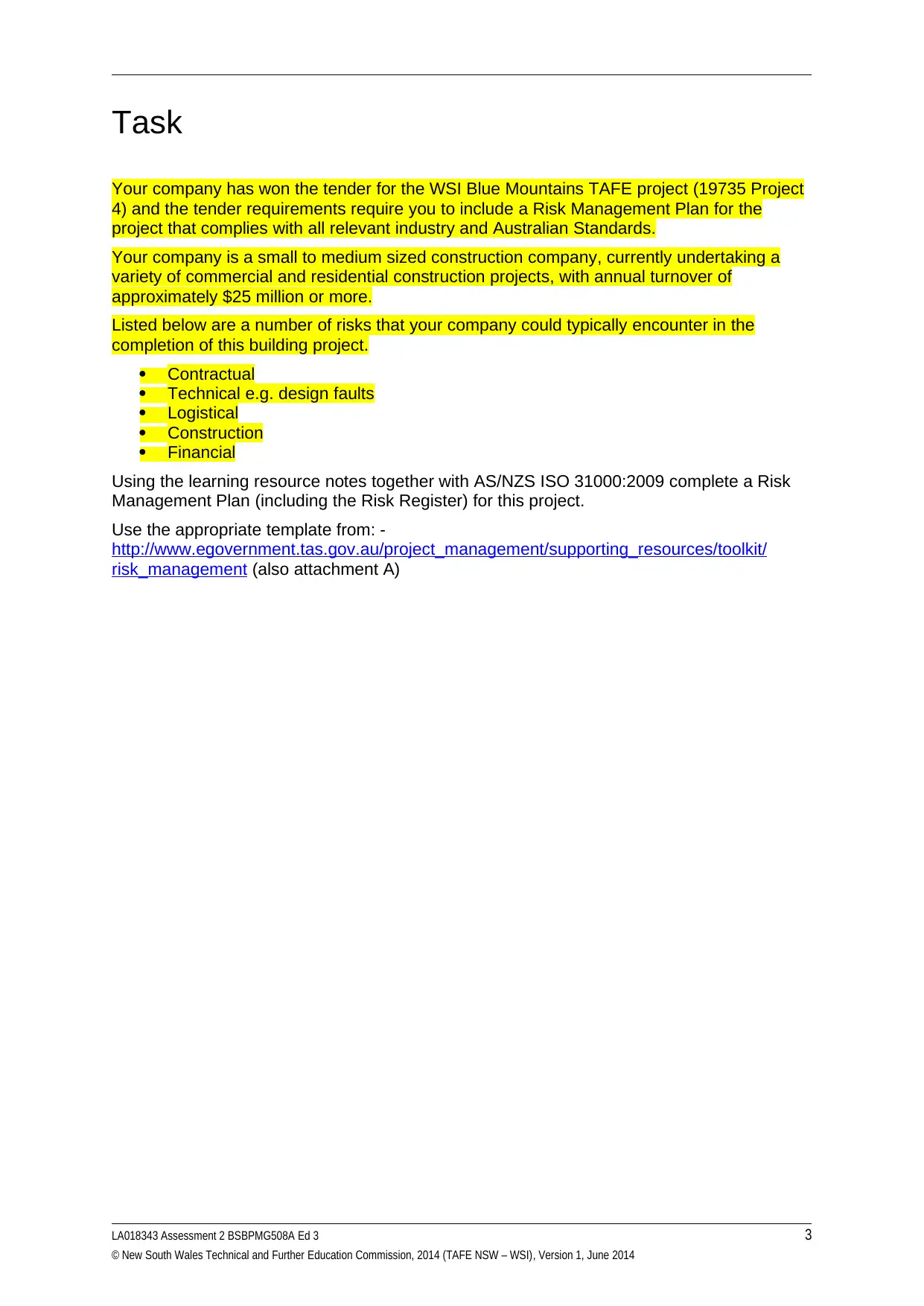
Task
Your company has won the tender for the WSI Blue Mountains TAFE project (19735 Project
4) and the tender requirements require you to include a Risk Management Plan for the
project that complies with all relevant industry and Australian Standards.
Your company is a small to medium sized construction company, currently undertaking a
variety of commercial and residential construction projects, with annual turnover of
approximately $25 million or more.
Listed below are a number of risks that your company could typically encounter in the
completion of this building project.
Contractual
Technical e.g. design faults
Logistical
Construction
Financial
Using the learning resource notes together with AS/NZS ISO 31000:2009 complete a Risk
Management Plan (including the Risk Register) for this project.
Use the appropriate template from: -
http://www.egovernment.tas.gov.au/project_management/supporting_resources/toolkit/
risk_management (also attachment A)
LA018343 Assessment 2 BSBPMG508A Ed 3 3
© New South Wales Technical and Further Education Commission, 2014 (TAFE NSW – WSI), Version 1, June 2014
Your company has won the tender for the WSI Blue Mountains TAFE project (19735 Project
4) and the tender requirements require you to include a Risk Management Plan for the
project that complies with all relevant industry and Australian Standards.
Your company is a small to medium sized construction company, currently undertaking a
variety of commercial and residential construction projects, with annual turnover of
approximately $25 million or more.
Listed below are a number of risks that your company could typically encounter in the
completion of this building project.
Contractual
Technical e.g. design faults
Logistical
Construction
Financial
Using the learning resource notes together with AS/NZS ISO 31000:2009 complete a Risk
Management Plan (including the Risk Register) for this project.
Use the appropriate template from: -
http://www.egovernment.tas.gov.au/project_management/supporting_resources/toolkit/
risk_management (also attachment A)
LA018343 Assessment 2 BSBPMG508A Ed 3 3
© New South Wales Technical and Further Education Commission, 2014 (TAFE NSW – WSI), Version 1, June 2014
⊘ This is a preview!⊘
Do you want full access?
Subscribe today to unlock all pages.

Trusted by 1+ million students worldwide
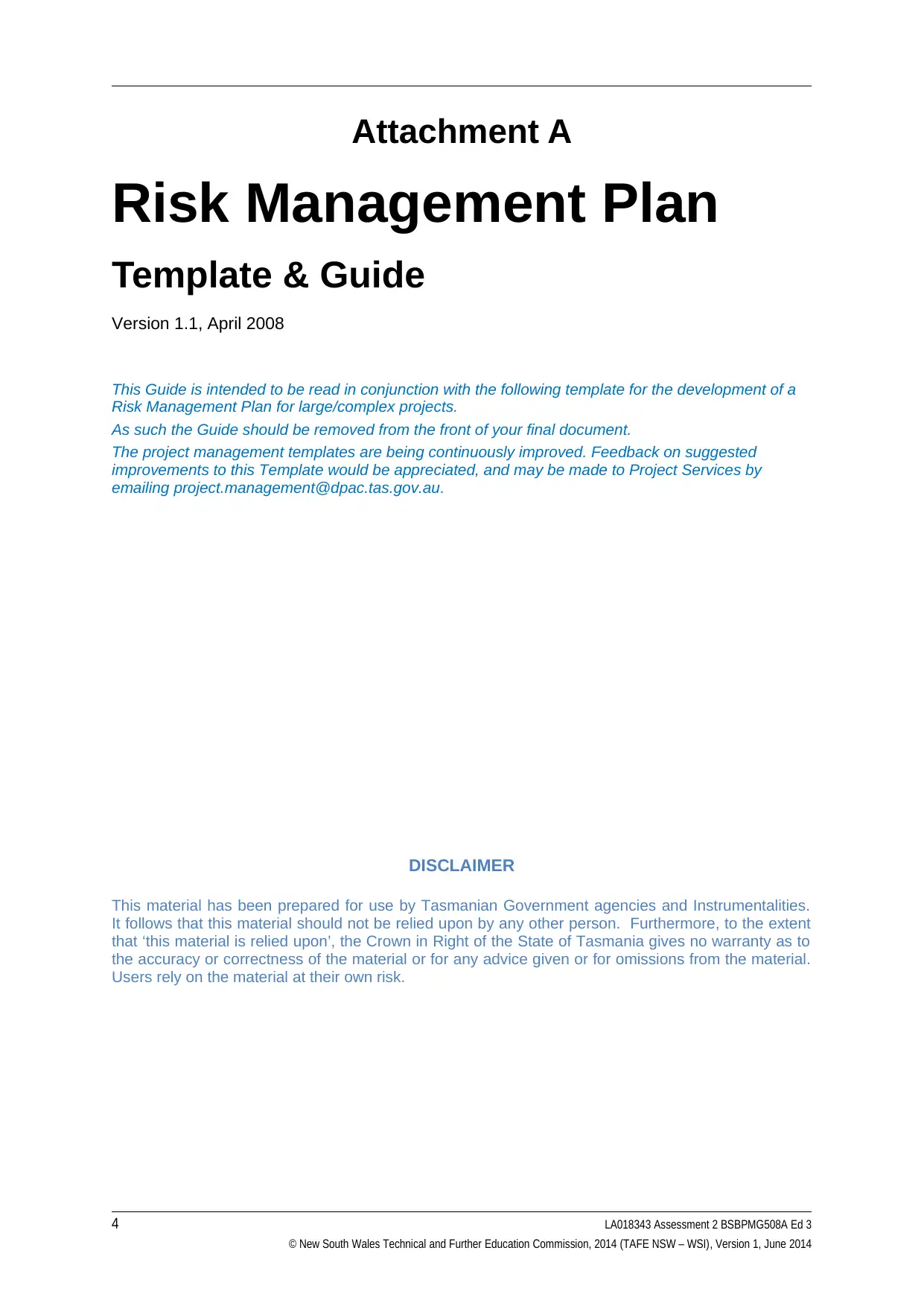
Attachment A
Risk Management Plan
Template & Guide
Version 1.1, April 2008
This Guide is intended to be read in conjunction with the following template for the development of a
Risk Management Plan for large/complex projects.
As such the Guide should be removed from the front of your final document.
The project management templates are being continuously improved. Feedback on suggested
improvements to this Template would be appreciated, and may be made to Project Services by
emailing project.management@dpac.tas.gov.au.
DISCLAIMER
This material has been prepared for use by Tasmanian Government agencies and Instrumentalities.
It follows that this material should not be relied upon by any other person. Furthermore, to the extent
that ‘this material is relied upon’, the Crown in Right of the State of Tasmania gives no warranty as to
the accuracy or correctness of the material or for any advice given or for omissions from the material.
Users rely on the material at their own risk.
4 LA018343 Assessment 2 BSBPMG508A Ed 3
© New South Wales Technical and Further Education Commission, 2014 (TAFE NSW – WSI), Version 1, June 2014
Risk Management Plan
Template & Guide
Version 1.1, April 2008
This Guide is intended to be read in conjunction with the following template for the development of a
Risk Management Plan for large/complex projects.
As such the Guide should be removed from the front of your final document.
The project management templates are being continuously improved. Feedback on suggested
improvements to this Template would be appreciated, and may be made to Project Services by
emailing project.management@dpac.tas.gov.au.
DISCLAIMER
This material has been prepared for use by Tasmanian Government agencies and Instrumentalities.
It follows that this material should not be relied upon by any other person. Furthermore, to the extent
that ‘this material is relied upon’, the Crown in Right of the State of Tasmania gives no warranty as to
the accuracy or correctness of the material or for any advice given or for omissions from the material.
Users rely on the material at their own risk.
4 LA018343 Assessment 2 BSBPMG508A Ed 3
© New South Wales Technical and Further Education Commission, 2014 (TAFE NSW – WSI), Version 1, June 2014
Paraphrase This Document
Need a fresh take? Get an instant paraphrase of this document with our AI Paraphraser
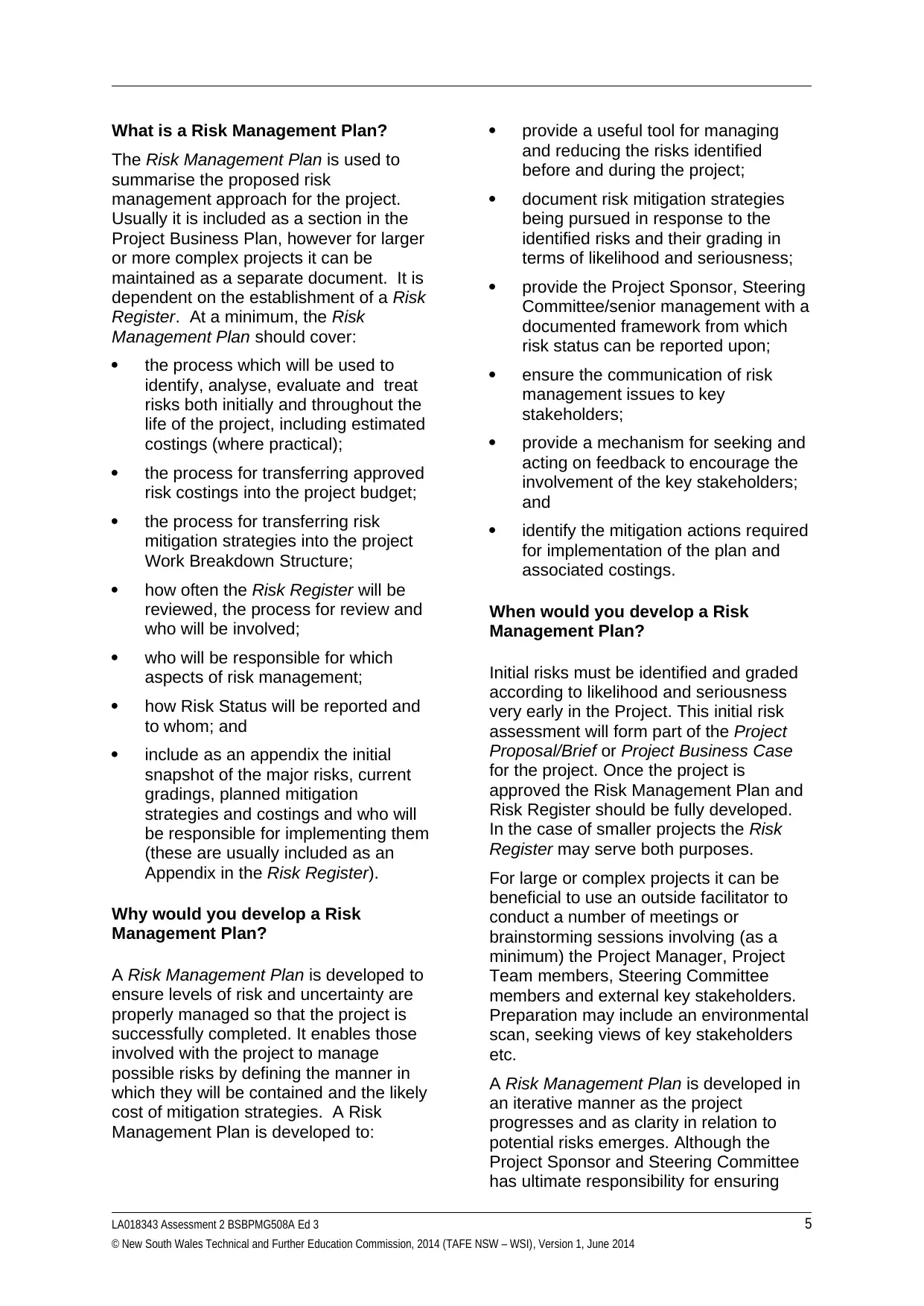
What is a Risk Management Plan?
The Risk Management Plan is used to
summarise the proposed risk
management approach for the project.
Usually it is included as a section in the
Project Business Plan, however for larger
or more complex projects it can be
maintained as a separate document. It is
dependent on the establishment of a Risk
Register. At a minimum, the Risk
Management Plan should cover:
the process which will be used to
identify, analyse, evaluate and treat
risks both initially and throughout the
life of the project, including estimated
costings (where practical);
the process for transferring approved
risk costings into the project budget;
the process for transferring risk
mitigation strategies into the project
Work Breakdown Structure;
how often the Risk Register will be
reviewed, the process for review and
who will be involved;
who will be responsible for which
aspects of risk management;
how Risk Status will be reported and
to whom; and
include as an appendix the initial
snapshot of the major risks, current
gradings, planned mitigation
strategies and costings and who will
be responsible for implementing them
(these are usually included as an
Appendix in the Risk Register).
Why would you develop a Risk
Management Plan?
A Risk Management Plan is developed to
ensure levels of risk and uncertainty are
properly managed so that the project is
successfully completed. It enables those
involved with the project to manage
possible risks by defining the manner in
which they will be contained and the likely
cost of mitigation strategies. A Risk
Management Plan is developed to:
provide a useful tool for managing
and reducing the risks identified
before and during the project;
document risk mitigation strategies
being pursued in response to the
identified risks and their grading in
terms of likelihood and seriousness;
provide the Project Sponsor, Steering
Committee/senior management with a
documented framework from which
risk status can be reported upon;
ensure the communication of risk
management issues to key
stakeholders;
provide a mechanism for seeking and
acting on feedback to encourage the
involvement of the key stakeholders;
and
identify the mitigation actions required
for implementation of the plan and
associated costings.
When would you develop a Risk
Management Plan?
Initial risks must be identified and graded
according to likelihood and seriousness
very early in the Project. This initial risk
assessment will form part of the Project
Proposal/Brief or Project Business Case
for the project. Once the project is
approved the Risk Management Plan and
Risk Register should be fully developed.
In the case of smaller projects the Risk
Register may serve both purposes.
For large or complex projects it can be
beneficial to use an outside facilitator to
conduct a number of meetings or
brainstorming sessions involving (as a
minimum) the Project Manager, Project
Team members, Steering Committee
members and external key stakeholders.
Preparation may include an environmental
scan, seeking views of key stakeholders
etc.
A Risk Management Plan is developed in
an iterative manner as the project
progresses and as clarity in relation to
potential risks emerges. Although the
Project Sponsor and Steering Committee
has ultimate responsibility for ensuring
LA018343 Assessment 2 BSBPMG508A Ed 3 5
© New South Wales Technical and Further Education Commission, 2014 (TAFE NSW – WSI), Version 1, June 2014
The Risk Management Plan is used to
summarise the proposed risk
management approach for the project.
Usually it is included as a section in the
Project Business Plan, however for larger
or more complex projects it can be
maintained as a separate document. It is
dependent on the establishment of a Risk
Register. At a minimum, the Risk
Management Plan should cover:
the process which will be used to
identify, analyse, evaluate and treat
risks both initially and throughout the
life of the project, including estimated
costings (where practical);
the process for transferring approved
risk costings into the project budget;
the process for transferring risk
mitigation strategies into the project
Work Breakdown Structure;
how often the Risk Register will be
reviewed, the process for review and
who will be involved;
who will be responsible for which
aspects of risk management;
how Risk Status will be reported and
to whom; and
include as an appendix the initial
snapshot of the major risks, current
gradings, planned mitigation
strategies and costings and who will
be responsible for implementing them
(these are usually included as an
Appendix in the Risk Register).
Why would you develop a Risk
Management Plan?
A Risk Management Plan is developed to
ensure levels of risk and uncertainty are
properly managed so that the project is
successfully completed. It enables those
involved with the project to manage
possible risks by defining the manner in
which they will be contained and the likely
cost of mitigation strategies. A Risk
Management Plan is developed to:
provide a useful tool for managing
and reducing the risks identified
before and during the project;
document risk mitigation strategies
being pursued in response to the
identified risks and their grading in
terms of likelihood and seriousness;
provide the Project Sponsor, Steering
Committee/senior management with a
documented framework from which
risk status can be reported upon;
ensure the communication of risk
management issues to key
stakeholders;
provide a mechanism for seeking and
acting on feedback to encourage the
involvement of the key stakeholders;
and
identify the mitigation actions required
for implementation of the plan and
associated costings.
When would you develop a Risk
Management Plan?
Initial risks must be identified and graded
according to likelihood and seriousness
very early in the Project. This initial risk
assessment will form part of the Project
Proposal/Brief or Project Business Case
for the project. Once the project is
approved the Risk Management Plan and
Risk Register should be fully developed.
In the case of smaller projects the Risk
Register may serve both purposes.
For large or complex projects it can be
beneficial to use an outside facilitator to
conduct a number of meetings or
brainstorming sessions involving (as a
minimum) the Project Manager, Project
Team members, Steering Committee
members and external key stakeholders.
Preparation may include an environmental
scan, seeking views of key stakeholders
etc.
A Risk Management Plan is developed in
an iterative manner as the project
progresses and as clarity in relation to
potential risks emerges. Although the
Project Sponsor and Steering Committee
has ultimate responsibility for ensuring
LA018343 Assessment 2 BSBPMG508A Ed 3 5
© New South Wales Technical and Further Education Commission, 2014 (TAFE NSW – WSI), Version 1, June 2014
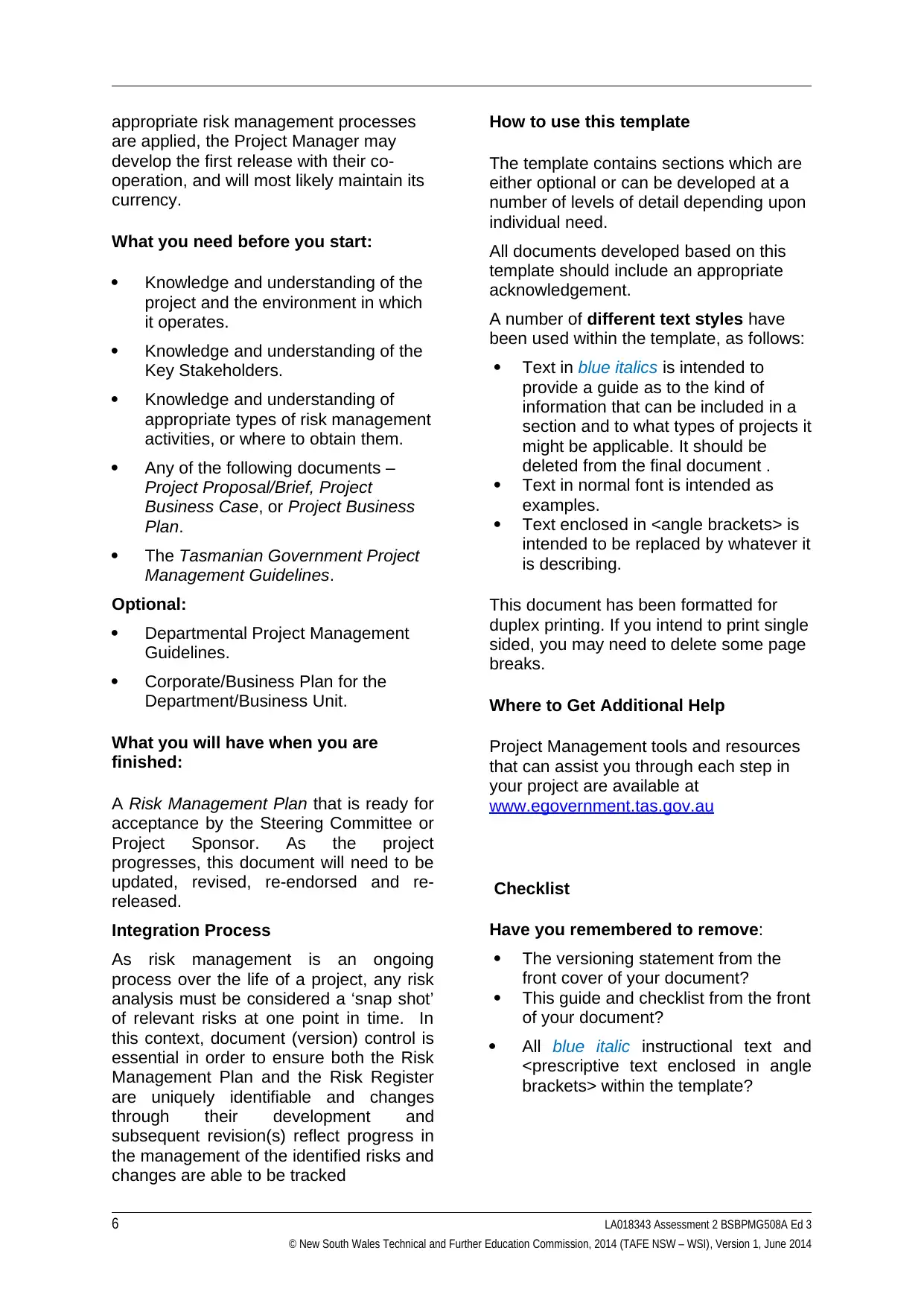
appropriate risk management processes
are applied, the Project Manager may
develop the first release with their co-
operation, and will most likely maintain its
currency.
What you need before you start:
Knowledge and understanding of the
project and the environment in which
it operates.
Knowledge and understanding of the
Key Stakeholders.
Knowledge and understanding of
appropriate types of risk management
activities, or where to obtain them.
Any of the following documents –
Project Proposal/Brief, Project
Business Case, or Project Business
Plan.
The Tasmanian Government Project
Management Guidelines.
Optional:
Departmental Project Management
Guidelines.
Corporate/Business Plan for the
Department/Business Unit.
What you will have when you are
finished:
A Risk Management Plan that is ready for
acceptance by the Steering Committee or
Project Sponsor. As the project
progresses, this document will need to be
updated, revised, re-endorsed and re-
released.
Integration Process
As risk management is an ongoing
process over the life of a project, any risk
analysis must be considered a ‘snap shot’
of relevant risks at one point in time. In
this context, document (version) control is
essential in order to ensure both the Risk
Management Plan and the Risk Register
are uniquely identifiable and changes
through their development and
subsequent revision(s) reflect progress in
the management of the identified risks and
changes are able to be tracked
How to use this template
The template contains sections which are
either optional or can be developed at a
number of levels of detail depending upon
individual need.
All documents developed based on this
template should include an appropriate
acknowledgement.
A number of different text styles have
been used within the template, as follows:
Text in blue italics is intended to
provide a guide as to the kind of
information that can be included in a
section and to what types of projects it
might be applicable. It should be
deleted from the final document .
Text in normal font is intended as
examples.
Text enclosed in <angle brackets> is
intended to be replaced by whatever it
is describing.
This document has been formatted for
duplex printing. If you intend to print single
sided, you may need to delete some page
breaks.
Where to Get Additional Help
Project Management tools and resources
that can assist you through each step in
your project are available at
www.egovernment.tas.gov.au
Checklist
Have you remembered to remove:
The versioning statement from the
front cover of your document?
This guide and checklist from the front
of your document?
All blue italic instructional text and
<prescriptive text enclosed in angle
brackets> within the template?
6 LA018343 Assessment 2 BSBPMG508A Ed 3
© New South Wales Technical and Further Education Commission, 2014 (TAFE NSW – WSI), Version 1, June 2014
are applied, the Project Manager may
develop the first release with their co-
operation, and will most likely maintain its
currency.
What you need before you start:
Knowledge and understanding of the
project and the environment in which
it operates.
Knowledge and understanding of the
Key Stakeholders.
Knowledge and understanding of
appropriate types of risk management
activities, or where to obtain them.
Any of the following documents –
Project Proposal/Brief, Project
Business Case, or Project Business
Plan.
The Tasmanian Government Project
Management Guidelines.
Optional:
Departmental Project Management
Guidelines.
Corporate/Business Plan for the
Department/Business Unit.
What you will have when you are
finished:
A Risk Management Plan that is ready for
acceptance by the Steering Committee or
Project Sponsor. As the project
progresses, this document will need to be
updated, revised, re-endorsed and re-
released.
Integration Process
As risk management is an ongoing
process over the life of a project, any risk
analysis must be considered a ‘snap shot’
of relevant risks at one point in time. In
this context, document (version) control is
essential in order to ensure both the Risk
Management Plan and the Risk Register
are uniquely identifiable and changes
through their development and
subsequent revision(s) reflect progress in
the management of the identified risks and
changes are able to be tracked
How to use this template
The template contains sections which are
either optional or can be developed at a
number of levels of detail depending upon
individual need.
All documents developed based on this
template should include an appropriate
acknowledgement.
A number of different text styles have
been used within the template, as follows:
Text in blue italics is intended to
provide a guide as to the kind of
information that can be included in a
section and to what types of projects it
might be applicable. It should be
deleted from the final document .
Text in normal font is intended as
examples.
Text enclosed in <angle brackets> is
intended to be replaced by whatever it
is describing.
This document has been formatted for
duplex printing. If you intend to print single
sided, you may need to delete some page
breaks.
Where to Get Additional Help
Project Management tools and resources
that can assist you through each step in
your project are available at
www.egovernment.tas.gov.au
Checklist
Have you remembered to remove:
The versioning statement from the
front cover of your document?
This guide and checklist from the front
of your document?
All blue italic instructional text and
<prescriptive text enclosed in angle
brackets> within the template?
6 LA018343 Assessment 2 BSBPMG508A Ed 3
© New South Wales Technical and Further Education Commission, 2014 (TAFE NSW – WSI), Version 1, June 2014
⊘ This is a preview!⊘
Do you want full access?
Subscribe today to unlock all pages.

Trusted by 1+ million students worldwide
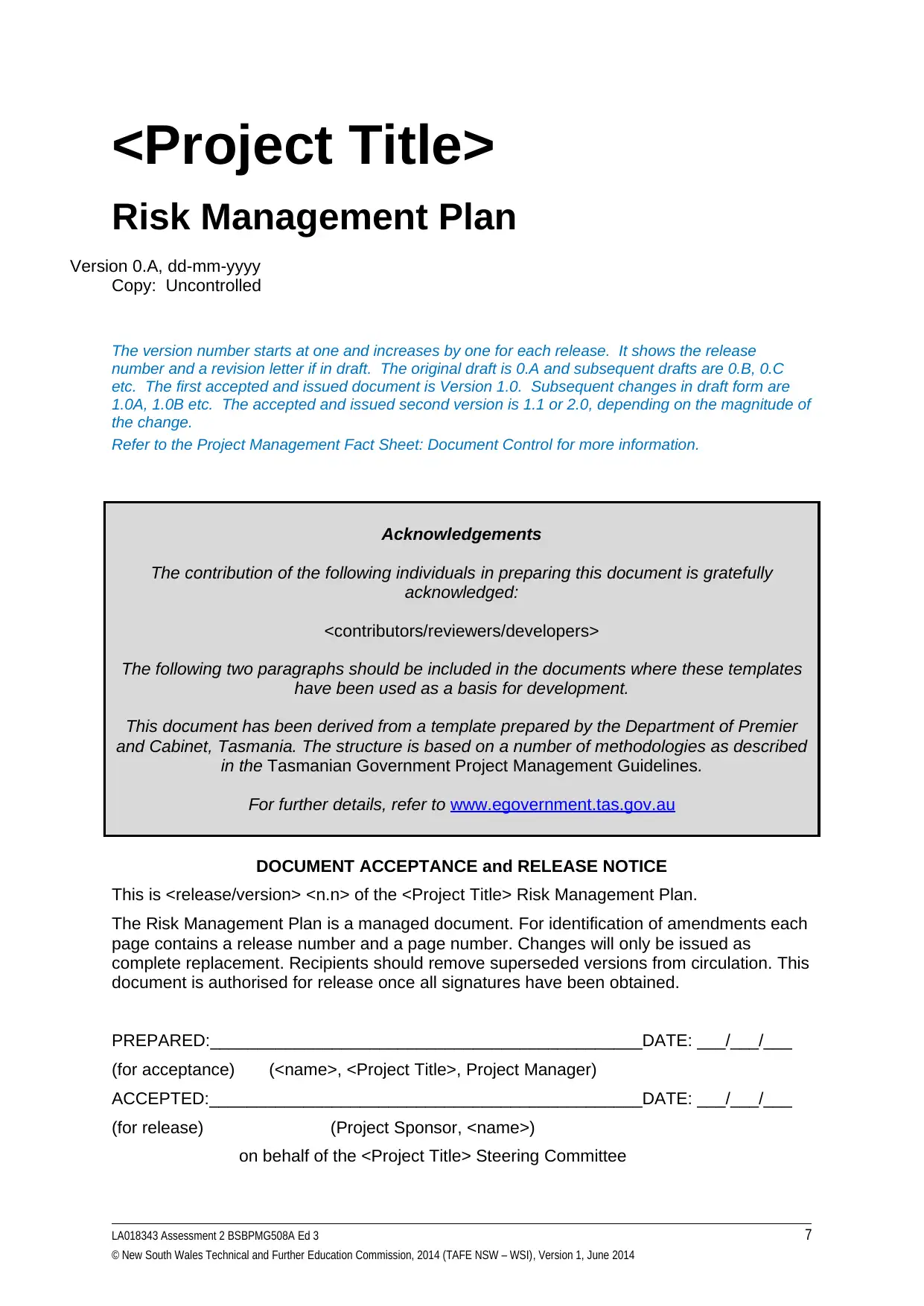
<Project Title>
Risk Management Plan
Version 0.A, dd-mm-yyyy
Copy: Uncontrolled
The version number starts at one and increases by one for each release. It shows the release
number and a revision letter if in draft. The original draft is 0.A and subsequent drafts are 0.B, 0.C
etc. The first accepted and issued document is Version 1.0. Subsequent changes in draft form are
1.0A, 1.0B etc. The accepted and issued second version is 1.1 or 2.0, depending on the magnitude of
the change.
Refer to the Project Management Fact Sheet: Document Control for more information.
Acknowledgements
The contribution of the following individuals in preparing this document is gratefully
acknowledged:
<contributors/reviewers/developers>
The following two paragraphs should be included in the documents where these templates
have been used as a basis for development.
This document has been derived from a template prepared by the Department of Premier
and Cabinet, Tasmania. The structure is based on a number of methodologies as described
in the Tasmanian Government Project Management Guidelines.
For further details, refer to www.egovernment.tas.gov.au
DOCUMENT ACCEPTANCE and RELEASE NOTICE
This is <release/version> <n.n> of the <Project Title> Risk Management Plan.
The Risk Management Plan is a managed document. For identification of amendments each
page contains a release number and a page number. Changes will only be issued as
complete replacement. Recipients should remove superseded versions from circulation. This
document is authorised for release once all signatures have been obtained.
PREPARED:______________________________________________DATE: ___/___/___
(for acceptance) (<name>, <Project Title>, Project Manager)
ACCEPTED:______________________________________________DATE: ___/___/___
(for release) (Project Sponsor, <name>)
on behalf of the <Project Title> Steering Committee
LA018343 Assessment 2 BSBPMG508A Ed 3 7
© New South Wales Technical and Further Education Commission, 2014 (TAFE NSW – WSI), Version 1, June 2014
Risk Management Plan
Version 0.A, dd-mm-yyyy
Copy: Uncontrolled
The version number starts at one and increases by one for each release. It shows the release
number and a revision letter if in draft. The original draft is 0.A and subsequent drafts are 0.B, 0.C
etc. The first accepted and issued document is Version 1.0. Subsequent changes in draft form are
1.0A, 1.0B etc. The accepted and issued second version is 1.1 or 2.0, depending on the magnitude of
the change.
Refer to the Project Management Fact Sheet: Document Control for more information.
Acknowledgements
The contribution of the following individuals in preparing this document is gratefully
acknowledged:
<contributors/reviewers/developers>
The following two paragraphs should be included in the documents where these templates
have been used as a basis for development.
This document has been derived from a template prepared by the Department of Premier
and Cabinet, Tasmania. The structure is based on a number of methodologies as described
in the Tasmanian Government Project Management Guidelines.
For further details, refer to www.egovernment.tas.gov.au
DOCUMENT ACCEPTANCE and RELEASE NOTICE
This is <release/version> <n.n> of the <Project Title> Risk Management Plan.
The Risk Management Plan is a managed document. For identification of amendments each
page contains a release number and a page number. Changes will only be issued as
complete replacement. Recipients should remove superseded versions from circulation. This
document is authorised for release once all signatures have been obtained.
PREPARED:______________________________________________DATE: ___/___/___
(for acceptance) (<name>, <Project Title>, Project Manager)
ACCEPTED:______________________________________________DATE: ___/___/___
(for release) (Project Sponsor, <name>)
on behalf of the <Project Title> Steering Committee
LA018343 Assessment 2 BSBPMG508A Ed 3 7
© New South Wales Technical and Further Education Commission, 2014 (TAFE NSW – WSI), Version 1, June 2014
Paraphrase This Document
Need a fresh take? Get an instant paraphrase of this document with our AI Paraphraser

1. BUILD STATUS:
The most recent amendment first.
Version Date Author Reason Sections
<n.n> <dd mmm yyyy> <Name> <e.g. Initial Release> <All>
2. AMENDMENTS IN THIS RELEASE:
Section Title Section
Number
Amendment Summary
<e.g. This is the first release of this document.>
3. DISTRIBUTION:
Copy No Version Issue Date Issued To
1 <n.n> <dd mmm yyyy> <Name, Title, Organisation>
2
Electronic
8 LA018343 Assessment 2 BSBPMG508A Ed 3
© New South Wales Technical and Further Education Commission, 2014 (TAFE NSW – WSI), Version 1, June 2014
The most recent amendment first.
Version Date Author Reason Sections
<n.n> <dd mmm yyyy> <Name> <e.g. Initial Release> <All>
2. AMENDMENTS IN THIS RELEASE:
Section Title Section
Number
Amendment Summary
<e.g. This is the first release of this document.>
3. DISTRIBUTION:
Copy No Version Issue Date Issued To
1 <n.n> <dd mmm yyyy> <Name, Title, Organisation>
2
Electronic
8 LA018343 Assessment 2 BSBPMG508A Ed 3
© New South Wales Technical and Further Education Commission, 2014 (TAFE NSW – WSI), Version 1, June 2014
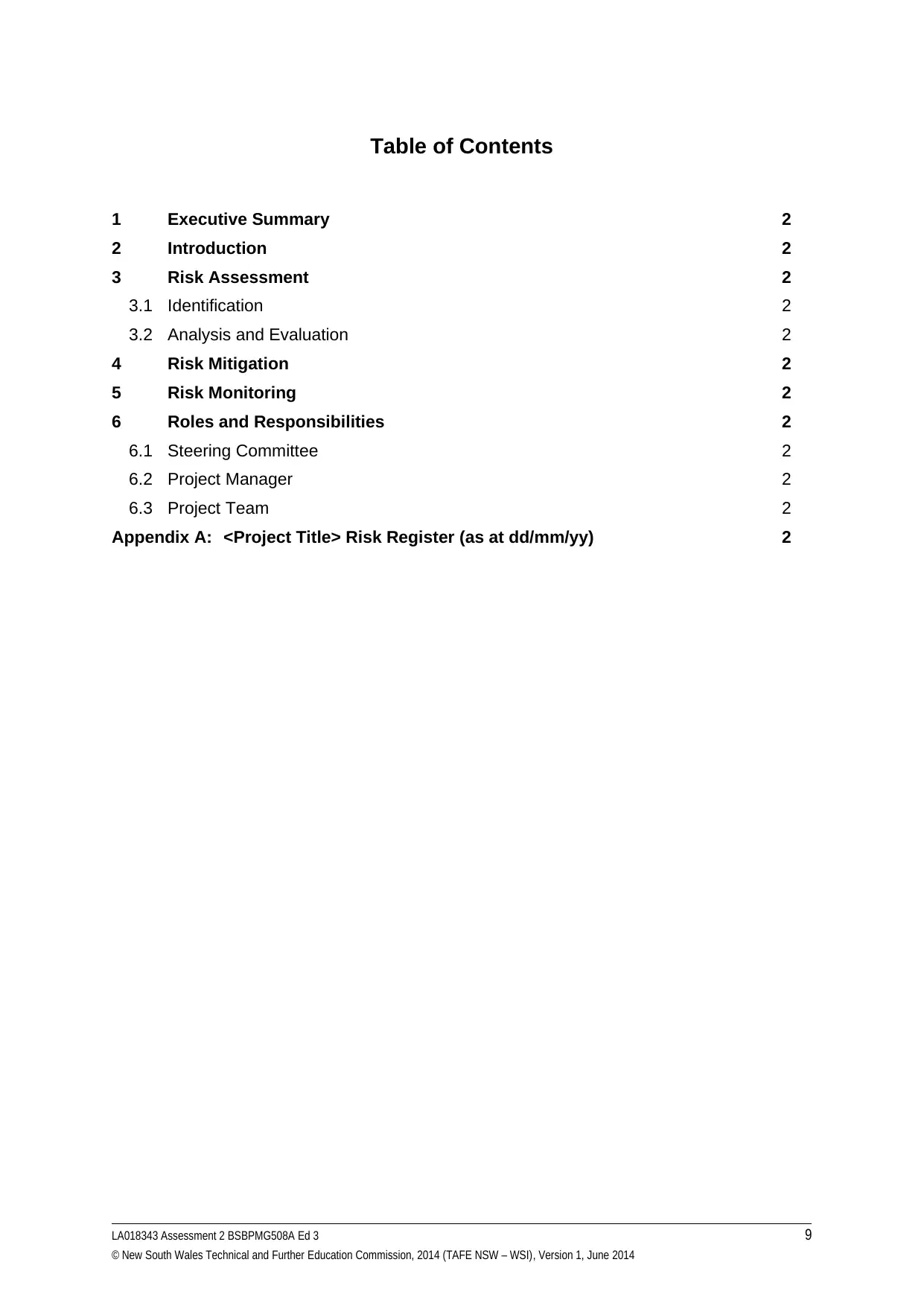
Table of Contents
1 Executive Summary 2
2 Introduction 2
3 Risk Assessment 2
3.1 Identification 2
3.2 Analysis and Evaluation 2
4 Risk Mitigation 2
5 Risk Monitoring 2
6 Roles and Responsibilities 2
6.1 Steering Committee 2
6.2 Project Manager 2
6.3 Project Team 2
Appendix A: <Project Title> Risk Register (as at dd/mm/yy) 2
LA018343 Assessment 2 BSBPMG508A Ed 3 9
© New South Wales Technical and Further Education Commission, 2014 (TAFE NSW – WSI), Version 1, June 2014
1 Executive Summary 2
2 Introduction 2
3 Risk Assessment 2
3.1 Identification 2
3.2 Analysis and Evaluation 2
4 Risk Mitigation 2
5 Risk Monitoring 2
6 Roles and Responsibilities 2
6.1 Steering Committee 2
6.2 Project Manager 2
6.3 Project Team 2
Appendix A: <Project Title> Risk Register (as at dd/mm/yy) 2
LA018343 Assessment 2 BSBPMG508A Ed 3 9
© New South Wales Technical and Further Education Commission, 2014 (TAFE NSW – WSI), Version 1, June 2014
⊘ This is a preview!⊘
Do you want full access?
Subscribe today to unlock all pages.

Trusted by 1+ million students worldwide
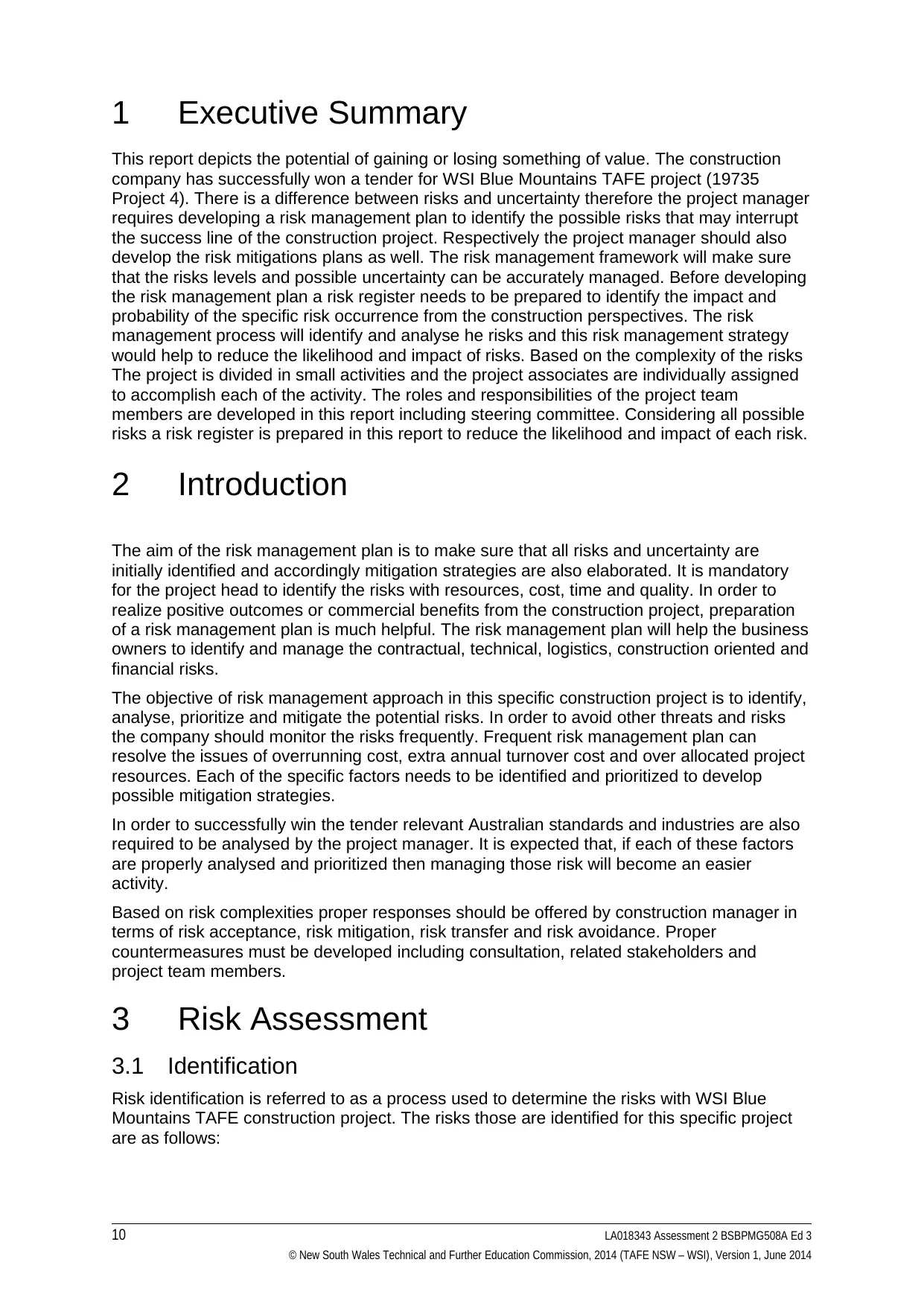
1 Executive Summary
This report depicts the potential of gaining or losing something of value. The construction
company has successfully won a tender for WSI Blue Mountains TAFE project (19735
Project 4). There is a difference between risks and uncertainty therefore the project manager
requires developing a risk management plan to identify the possible risks that may interrupt
the success line of the construction project. Respectively the project manager should also
develop the risk mitigations plans as well. The risk management framework will make sure
that the risks levels and possible uncertainty can be accurately managed. Before developing
the risk management plan a risk register needs to be prepared to identify the impact and
probability of the specific risk occurrence from the construction perspectives. The risk
management process will identify and analyse he risks and this risk management strategy
would help to reduce the likelihood and impact of risks. Based on the complexity of the risks
The project is divided in small activities and the project associates are individually assigned
to accomplish each of the activity. The roles and responsibilities of the project team
members are developed in this report including steering committee. Considering all possible
risks a risk register is prepared in this report to reduce the likelihood and impact of each risk.
2 Introduction
The aim of the risk management plan is to make sure that all risks and uncertainty are
initially identified and accordingly mitigation strategies are also elaborated. It is mandatory
for the project head to identify the risks with resources, cost, time and quality. In order to
realize positive outcomes or commercial benefits from the construction project, preparation
of a risk management plan is much helpful. The risk management plan will help the business
owners to identify and manage the contractual, technical, logistics, construction oriented and
financial risks.
The objective of risk management approach in this specific construction project is to identify,
analyse, prioritize and mitigate the potential risks. In order to avoid other threats and risks
the company should monitor the risks frequently. Frequent risk management plan can
resolve the issues of overrunning cost, extra annual turnover cost and over allocated project
resources. Each of the specific factors needs to be identified and prioritized to develop
possible mitigation strategies.
In order to successfully win the tender relevant Australian standards and industries are also
required to be analysed by the project manager. It is expected that, if each of these factors
are properly analysed and prioritized then managing those risk will become an easier
activity.
Based on risk complexities proper responses should be offered by construction manager in
terms of risk acceptance, risk mitigation, risk transfer and risk avoidance. Proper
countermeasures must be developed including consultation, related stakeholders and
project team members.
3 Risk Assessment
3.1 Identification
Risk identification is referred to as a process used to determine the risks with WSI Blue
Mountains TAFE construction project. The risks those are identified for this specific project
are as follows:
10 LA018343 Assessment 2 BSBPMG508A Ed 3
© New South Wales Technical and Further Education Commission, 2014 (TAFE NSW – WSI), Version 1, June 2014
This report depicts the potential of gaining or losing something of value. The construction
company has successfully won a tender for WSI Blue Mountains TAFE project (19735
Project 4). There is a difference between risks and uncertainty therefore the project manager
requires developing a risk management plan to identify the possible risks that may interrupt
the success line of the construction project. Respectively the project manager should also
develop the risk mitigations plans as well. The risk management framework will make sure
that the risks levels and possible uncertainty can be accurately managed. Before developing
the risk management plan a risk register needs to be prepared to identify the impact and
probability of the specific risk occurrence from the construction perspectives. The risk
management process will identify and analyse he risks and this risk management strategy
would help to reduce the likelihood and impact of risks. Based on the complexity of the risks
The project is divided in small activities and the project associates are individually assigned
to accomplish each of the activity. The roles and responsibilities of the project team
members are developed in this report including steering committee. Considering all possible
risks a risk register is prepared in this report to reduce the likelihood and impact of each risk.
2 Introduction
The aim of the risk management plan is to make sure that all risks and uncertainty are
initially identified and accordingly mitigation strategies are also elaborated. It is mandatory
for the project head to identify the risks with resources, cost, time and quality. In order to
realize positive outcomes or commercial benefits from the construction project, preparation
of a risk management plan is much helpful. The risk management plan will help the business
owners to identify and manage the contractual, technical, logistics, construction oriented and
financial risks.
The objective of risk management approach in this specific construction project is to identify,
analyse, prioritize and mitigate the potential risks. In order to avoid other threats and risks
the company should monitor the risks frequently. Frequent risk management plan can
resolve the issues of overrunning cost, extra annual turnover cost and over allocated project
resources. Each of the specific factors needs to be identified and prioritized to develop
possible mitigation strategies.
In order to successfully win the tender relevant Australian standards and industries are also
required to be analysed by the project manager. It is expected that, if each of these factors
are properly analysed and prioritized then managing those risk will become an easier
activity.
Based on risk complexities proper responses should be offered by construction manager in
terms of risk acceptance, risk mitigation, risk transfer and risk avoidance. Proper
countermeasures must be developed including consultation, related stakeholders and
project team members.
3 Risk Assessment
3.1 Identification
Risk identification is referred to as a process used to determine the risks with WSI Blue
Mountains TAFE construction project. The risks those are identified for this specific project
are as follows:
10 LA018343 Assessment 2 BSBPMG508A Ed 3
© New South Wales Technical and Further Education Commission, 2014 (TAFE NSW – WSI), Version 1, June 2014
Paraphrase This Document
Need a fresh take? Get an instant paraphrase of this document with our AI Paraphraser
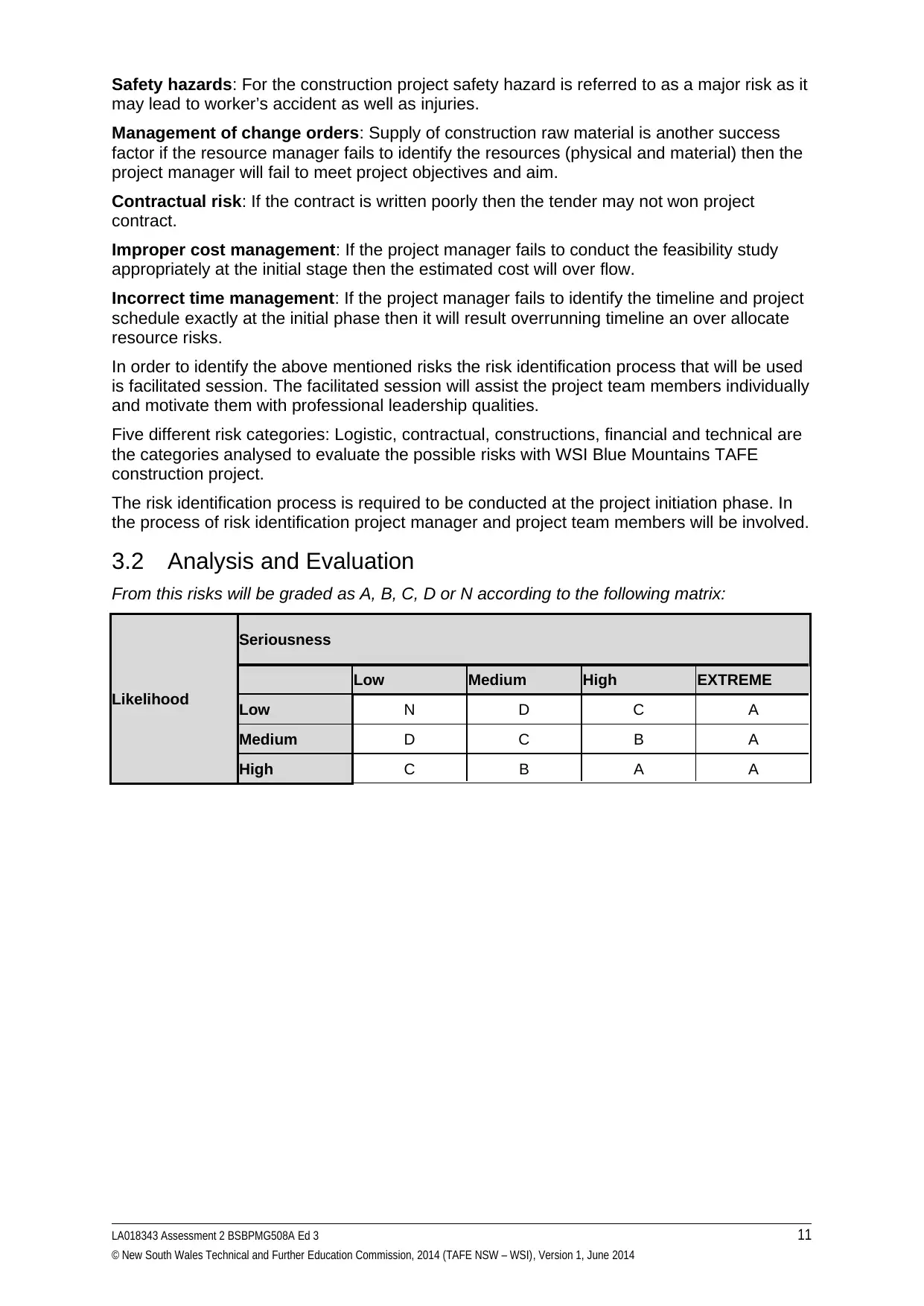
Safety hazards: For the construction project safety hazard is referred to as a major risk as it
may lead to worker’s accident as well as injuries.
Management of change orders: Supply of construction raw material is another success
factor if the resource manager fails to identify the resources (physical and material) then the
project manager will fail to meet project objectives and aim.
Contractual risk: If the contract is written poorly then the tender may not won project
contract.
Improper cost management: If the project manager fails to conduct the feasibility study
appropriately at the initial stage then the estimated cost will over flow.
Incorrect time management: If the project manager fails to identify the timeline and project
schedule exactly at the initial phase then it will result overrunning timeline an over allocate
resource risks.
In order to identify the above mentioned risks the risk identification process that will be used
is facilitated session. The facilitated session will assist the project team members individually
and motivate them with professional leadership qualities.
Five different risk categories: Logistic, contractual, constructions, financial and technical are
the categories analysed to evaluate the possible risks with WSI Blue Mountains TAFE
construction project.
The risk identification process is required to be conducted at the project initiation phase. In
the process of risk identification project manager and project team members will be involved.
3.2 Analysis and Evaluation
From this risks will be graded as A, B, C, D or N according to the following matrix:
Likelihood
Seriousness
Low Medium High EXTREME
Low N D C A
Medium D C B A
High C B A A
LA018343 Assessment 2 BSBPMG508A Ed 3 11
© New South Wales Technical and Further Education Commission, 2014 (TAFE NSW – WSI), Version 1, June 2014
may lead to worker’s accident as well as injuries.
Management of change orders: Supply of construction raw material is another success
factor if the resource manager fails to identify the resources (physical and material) then the
project manager will fail to meet project objectives and aim.
Contractual risk: If the contract is written poorly then the tender may not won project
contract.
Improper cost management: If the project manager fails to conduct the feasibility study
appropriately at the initial stage then the estimated cost will over flow.
Incorrect time management: If the project manager fails to identify the timeline and project
schedule exactly at the initial phase then it will result overrunning timeline an over allocate
resource risks.
In order to identify the above mentioned risks the risk identification process that will be used
is facilitated session. The facilitated session will assist the project team members individually
and motivate them with professional leadership qualities.
Five different risk categories: Logistic, contractual, constructions, financial and technical are
the categories analysed to evaluate the possible risks with WSI Blue Mountains TAFE
construction project.
The risk identification process is required to be conducted at the project initiation phase. In
the process of risk identification project manager and project team members will be involved.
3.2 Analysis and Evaluation
From this risks will be graded as A, B, C, D or N according to the following matrix:
Likelihood
Seriousness
Low Medium High EXTREME
Low N D C A
Medium D C B A
High C B A A
LA018343 Assessment 2 BSBPMG508A Ed 3 11
© New South Wales Technical and Further Education Commission, 2014 (TAFE NSW – WSI), Version 1, June 2014
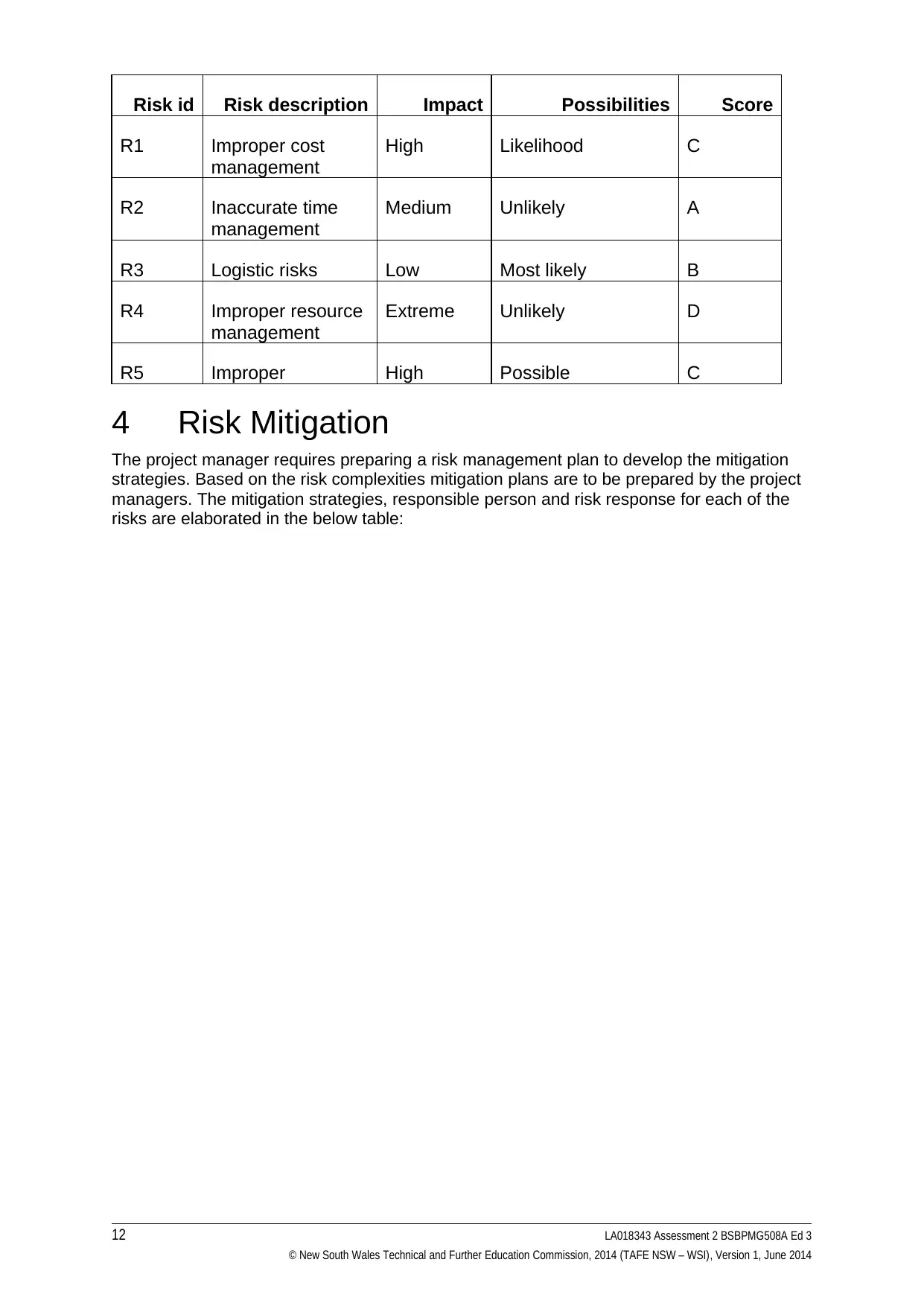
Risk id Risk description Impact Possibilities Score
R1 Improper cost
management
High Likelihood C
R2 Inaccurate time
management
Medium Unlikely A
R3 Logistic risks Low Most likely B
R4 Improper resource
management
Extreme Unlikely D
R5 Improper High Possible C
4 Risk Mitigation
The project manager requires preparing a risk management plan to develop the mitigation
strategies. Based on the risk complexities mitigation plans are to be prepared by the project
managers. The mitigation strategies, responsible person and risk response for each of the
risks are elaborated in the below table:
12 LA018343 Assessment 2 BSBPMG508A Ed 3
© New South Wales Technical and Further Education Commission, 2014 (TAFE NSW – WSI), Version 1, June 2014
R1 Improper cost
management
High Likelihood C
R2 Inaccurate time
management
Medium Unlikely A
R3 Logistic risks Low Most likely B
R4 Improper resource
management
Extreme Unlikely D
R5 Improper High Possible C
4 Risk Mitigation
The project manager requires preparing a risk management plan to develop the mitigation
strategies. Based on the risk complexities mitigation plans are to be prepared by the project
managers. The mitigation strategies, responsible person and risk response for each of the
risks are elaborated in the below table:
12 LA018343 Assessment 2 BSBPMG508A Ed 3
© New South Wales Technical and Further Education Commission, 2014 (TAFE NSW – WSI), Version 1, June 2014
⊘ This is a preview!⊘
Do you want full access?
Subscribe today to unlock all pages.

Trusted by 1+ million students worldwide
1 out of 23
Related Documents
Your All-in-One AI-Powered Toolkit for Academic Success.
+13062052269
info@desklib.com
Available 24*7 on WhatsApp / Email
![[object Object]](/_next/static/media/star-bottom.7253800d.svg)
Unlock your academic potential
Copyright © 2020–2025 A2Z Services. All Rights Reserved. Developed and managed by ZUCOL.



